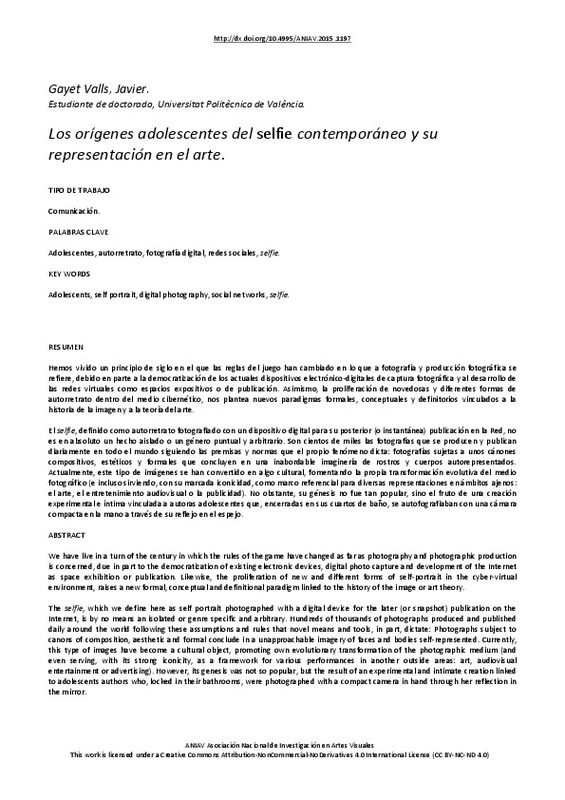JavaScript is disabled for your browser. Some features of this site may not work without it.
Buscar en RiuNet
Listar
Mi cuenta
Estadísticas
Ayuda RiuNet
Admin. UPV
LOS ORÍGENES ADOLESCENTES DEL SELFIE CONTEMPORÁNEO Y SU REPRESENTACIÓN EN EL ARTE
Mostrar el registro sencillo del ítem
Ficheros en el ítem
| dc.contributor.author | Gayet Valls, Javier
|
es_ES |
| dc.date.accessioned | 2018-02-15T08:30:28Z | |
| dc.date.available | 2018-02-15T08:30:28Z | |
| dc.date.issued | 2015-11-26 | |
| dc.identifier.isbn | 9788490483411 | |
| dc.identifier.uri | http://hdl.handle.net/10251/97946 | |
| dc.description.abstract | [EN] We have live in a turn of the century in which the rules of the game have changed as far as photography and photographic production is concerned, due in part to the democratization of existing electronic devices, digital photo capture and development of the Internet as space exhibition or publication. Likewise, the proliferation of new and different forms of self-portrait in the cyber-virtual environment, raises a new formal, conceptual and definitional paradigm linked to the history of the image or art theory. The selfie, which we define here as self portrait photographed with a digital device for the later (or snapshot) publication on the Internet, is by no means an isolated or genre specific and arbitrary. Hundreds of thousands of photographs produced and published daily around the world following these assumptions and rules that novel means and tools, in part, dictate: Photographs subject to canons of composition, aesthetic and formal conclude in a unapproachable imagery of faces and bodies self-represented. Currently, this type of images have become a cultural object, promoting own evolutionary transformation of the photographic medium (and even serving, with its strong iconicity, as a framework for various performances in another outside areas: art, audiovisual entertainment or advertising). However, its genesis was not so popular, but the result of an experimental and intimate creation linked to adolescents authors who, locked in their bathrooms, were photographed with a compact camera in hand through her reflection in the mirror. | es_ES |
| dc.description.abstract | [ES] Hemos vivido un principio de siglo en el que las reglas del juego han cambiado en lo que a fotografía y producción fotográfica se refiere, debido en parte a la democratización de los actuales dispositivos electrónico-digitales de captura fotográfica y al desarrollo de las redes virtuales como espacios expositivos o de publicación. Asimismo, la proliferación de novedosas y diferentes formas de autorretrato dentro del medio cibernético, nos plantea nuevos paradigmas formales, conceptuales y definitorios vinculados a la historia de la imagen y a la teoría del arte.El selfie, definido como autorretrato fotografiado con un dispositivo digital para su posterior (o instantánea) publicación en la Red, no es en absoluto un hecho aislado o un género puntual y arbitrario. Son cientos de miles las fotografías que se producen y publican diariamente en todo el mundo siguiendo las premisas y normas que el propio fenómeno dicta: fotografías sujetas a unos cánones compositivos, estéticos y formales que concluyen en una inabordable imaginería de rostros y cuerpos autorepresentados. Actualmente, este tipo de imágenes se han convertido en algo cultural, fomentando la propia transformación evolutiva del medio fotográfico (e incluso sirviendo, con su marcada iconicidad, como marco referencial para diversas representaciones en ámbitos ajenos: el arte, el cine o la publicidad). No obstante, su génesis no fue tan popular, sino el fruto de una creación experimental e íntima vinculada a autoras adolescentes que, encerradas en sus cuartos de baño, se autofografiaban con una cámara compacta en la mano a través de su reflejo en el espejo. | es_ES |
| dc.format.extent | 11 | es_ES |
| dc.language | Español | es_ES |
| dc.publisher | Editorial Universitat Politècnica de València | es_ES |
| dc.relation.ispartof | II CONGRESO INTERNACIONAL DE INVESTIGACIÓN EN ARTE VISUALES | es_ES |
| dc.rights | Reconocimiento - No comercial - Sin obra derivada (by-nc-nd) | es_ES |
| dc.subject | Adolescentes | es_ES |
| dc.subject | Autorretrato | es_ES |
| dc.subject | Fotografía digital | es_ES |
| dc.subject | Redes solciales | es_ES |
| dc.subject | Selfie | es_ES |
| dc.title | LOS ORÍGENES ADOLESCENTES DEL SELFIE CONTEMPORÁNEO Y SU REPRESENTACIÓN EN EL ARTE | es_ES |
| dc.type | Capítulo de libro | es_ES |
| dc.type | Comunicación en congreso | es_ES |
| dc.identifier.doi | 10.4995/ANIAV.2015.1197 | |
| dc.rights.accessRights | Abierto | es_ES |
| dc.contributor.affiliation | Universitat Politècnica de València. Departamento de Pintura - Departament de Pintura | es_ES |
| dc.contributor.affiliation | Universitat Politècnica de València. Centro de Investigación Arte y Entorno - Centre d'Investigació Art i Entorn | es_ES |
| dc.contributor.affiliation | Universitat Politècnica de València. Facultad de Bellas Artes - Facultat de Belles Arts | es_ES |
| dc.description.bibliographicCitation | Gayet Valls, J. (2015). LOS ORÍGENES ADOLESCENTES DEL SELFIE CONTEMPORÁNEO Y SU REPRESENTACIÓN EN EL ARTE. En II CONGRESO INTERNACIONAL DE INVESTIGACIÓN EN ARTE VISUALES. Editorial Universitat Politècnica de València. 304-314. https://doi.org/10.4995/ANIAV.2015.1197 | es_ES |
| dc.description.accrualMethod | OCS | es_ES |
| dc.relation.conferencename | II Congreso Internacional de Investigación en Artes Visuales. |< real | virtual >| ANIAV2015 | es_ES |
| dc.relation.conferencedate | July 09-10,2015 | es_ES |
| dc.relation.conferenceplace | Valencia | es_ES |
| dc.relation.publisherversion | http://ocs.editorial.upv.es/index.php/ANIAV/ANIAV2015/paper/view/1197 | es_ES |
| dc.description.upvformatpinicio | 304 | es_ES |
| dc.description.upvformatpfin | 314 | es_ES |
| dc.type.version | info:eu-repo/semantics/publishedVersion | es_ES |
| dc.relation.pasarela | OCS\1197 | es_ES |








